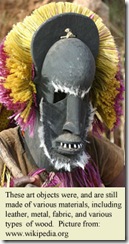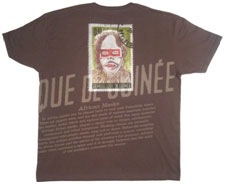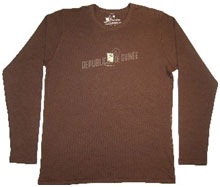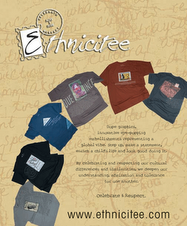For thousands of years, dating well before Paleolithic times, rituals and ceremonies incorporating traditional masks were and to a lesser extent still are integral parts of African life. The gradual effects of parceled out territories to Colonial governments, the ensuing damage to traditional economies, and the displacement of huge quantities of people due to Colonialism resulted in economies and food production systems being wrecked. In general, the vast number of Africa’s people has lost some of their tribal identity and culture, hence masking ceremonies are no longer common place in Africa.
 For many centuries, African tribal masks played a major role in:
For many centuries, African tribal masks played a major role in:
- Rituals
- Celebrations
- Ceremonial and Tribal Initiations
- Crop Harvesting
- War Preparation
- Times of Peace and Conflict
This stamp is from a set of 12 issued in Guinea in 1965.
During a mask ceremony, the mask-wearing dancer goes into a deep trance where he communicates and brings forth messages of wisdom from his ancestors. Rituals and ceremonies are always accompanied with music and dance, using traditional African musical instruments.
 Masks can be worn in three different ways:
Masks can be worn in three different ways:
- as face masks, vertically covering the face
- as helmets, encasing the entire head
- as crests, resting upon the head and commonly covered by material as part of the disguise
Masks in Africa have great tribal, cultural, and traditional significance.
To begin the sculpting process, a carver offers a sacrifice to the spirit of a tree. Once the tree is felled, the sculptor leaves it for a day or two, so that the spirit of the tree can find a “new home”. Afterwards, he brings the tree to his workshop to start the process of carving the mask. Prior to sculpting the mask, the artisan purifies himself and performs a prayer, consulting the divine forces and the spirits of his ancestors for guidance. The divine force will then be transferred to the mask during the sculpting process.
Q: “What are some similarities and differences you can recognize and celebrate between the African Mask and something you value in your culture?”
If you are interested in Ethnicitee African Tribal Mask apparel, click here!




1 comment:
The styles and designs of African masks differ according to each country and each tribe within that country. For example, the Dan people of the Ivory Coast and Liberia have wooden masks carved with African features, such as wide foreheads, flat noses, wide and full lips, accented by attached strands of rope to look like hair. The Punu people of Congo, Cameroon and Gabon have wooden masks with wooden hair, usually piled high as they represent wealthy women, and decorated with long strands of raffia along the jaw line. The whitened faces of these masks serve to scare off witches and evil spirits.
Post a Comment